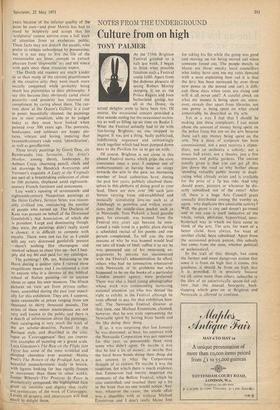ART
Royal occasions
EVAN ANTHONY
years because of the inferior quality of the paint he uses—and poor Morris has had to stand by helplessly and accept that his 'sculptures' cannot survive even a full week of attention from an exuberant public.
These facts may not disturb the ascetic, who prefer to remain unburdened by possessions, but it is not easy to live the life of the existentialist art lover, content to extract pleasure from 'disposable' art and not wince with pain once these treasures expire.
The Dutch old masters are much kinder to us than many of the current practitioners in the creative arts; they were much more socially concerned while probably being much less pretentious in their philosophy. I say this because they obviously cared about posterity—and posterity has returned the compliment by caring about them. The cur- rent show at the Queen's Gallery is a: case in point; beautifully cleaned, the paintings are in mint condition, able to be judged today as they must have looked when painted over 300 years ago. The portraits, landscapes, and tableaux are happy pic- tures, vibrant and loving, inspiring that twentieth-century code word, 'identification', as well as genuflection.
Three lovely paintings by Gerrit Doti, six Rembrandts (my favourite, The Artist's Mother, among them), landscapes by Aelburt Cuyp, charming ,pencil, chalk and ink drawings by Hendrick Avercamp, and Vermeer's exquisite A Lady at the Virginals are part of a breathtaking collection of close to 100 pictures, displayed amid eighteenth- century French furniture and ornaments.
Last week's opening of seventeenth- and eighteenth-century Neapolitan paintings at the Heim Gallery, Jermyn Street was reason- ably civilised too, considering the number of people who turned up. The Duchess of Kent was present on behalf of the Distressed Gentlefolk's Aid Association, of which she is president. Large and dominating though they were, the paintings didn't really stand a chance; it is difficult to compete with royalty. There were not (as far as I could tell) any very distressed gentlefolk present —there's nothing like champagne and smoked salmon to cheer you up—but I hap- pily did my bit and paid for my catalogue.
The paintings? Oh, yes. Returning to the Heim during a quieter time I viewed these magnificent beasts and I recommend a visit to anyone who is a devotee of the biblical school of Italian painting—or to anyone about to open his own museum. The fifteen pictures on view are from private collec- tions, assembled during the past year especi- ally for this exhibition. They are, I suppose, quite reasonable at prices ranging from ten thousand to thirty thousand pounds. The artists of these minor masterpieces are not very well known to the public and there is a dearth of information about the paintings; their cataloguing is very much the work of the art scholar-detective. Painted in the Baroque style, and described in the cata- logue as 'Caravaggesque' they are impres- sive examples of 'painting on a grand scale. Luca Giordano's The Rest on the Flight into Ell.vpt has some of the most wrinkled and dimpled cherubim ever painted; Mattia Preti's The Return of the Prodigal Son is a beautiful monochromatic study in brown, with figures looking far less rigidly frozen in movement than those in other works; Jusepe Ribera.'s The Penitent St Peter is dramatically composed, the highlighted face given an intensity and dignity that really are reminiscent of the work of Caravaggio. Lovers of drapery and chiaroscuro will find much to delight them.



































 Previous page
Previous page